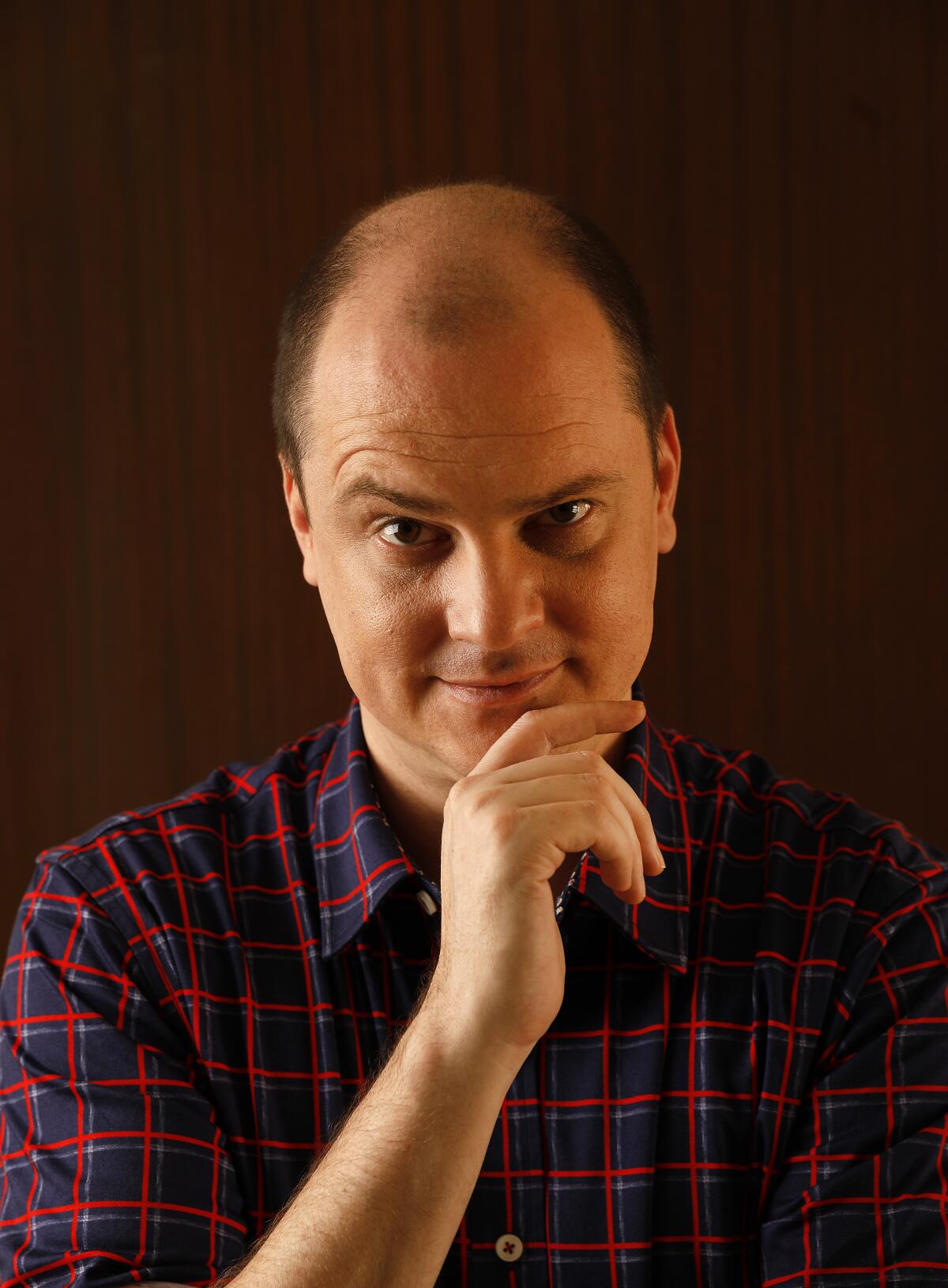How ‘Doctor Sleep’ earned Stephen King’s endorsement and still honored Stanley Kubrick
Director Mike Flanagan is no stranger to adapting Stephen King’s more difficult works. After all, his adaptation of “Gerald’s Game,” a story long considered to be unfilmable, was positively received in 2017.
But adapting King’s 2013 story “Doctor Sleep” in a way that did justice to both the author’s 1977 novel “The Shining” and Stanley Kubrick’s classic 1980 film adaptation — which drastically changed some key story points — was an entirely different beast.
“It was painfully clear to me that I am not Stanley Kubrick and never will be,” said Flanagan ahead of the film’s Nov. 8 wide release. “What made me able to sleep at night was, instead of thinking of it as a sequel, what if this was a descendant of the movie? What if it had the DNA of its parents but still has to stand on its own two feet and find a way in the world? That made it kind of possible.”
“Doctor Sleep” follows a grownup Dan Torrance (Ewan McGregor), who has tried to bury his traumatic boyhood experience at the Overlook Hotel in a haze of alcohol and sex. But the past catches up to him when he stumbles upon a cult dubbed the True Knot, led by the formidable Rose the Hat (Rebecca Ferguson), who feed off the essence of people with special abilities, like Dan’s “shining.”
Getting the approval and discussing plans for the film with King was “completely surreal,” Flanagan said. “The first time I talked to him I couldn’t speak. I think I just made noises or I’d repeat words he said back with authority.”
Although King was amenable to the idea, Flanagan was concerned about how the author would receive the film once it was completed.
“Once he’s said yes, he intentionally backs off,” Flanagan said. “His whole thing is, ‘The book is the book, I want this movie to be yours. I don’t want to interfere with it.’ Which is such a beautiful freedom. Except it means he’s going to watch it. And as Kubrick found out, if he doesn’t like what you did, he will not be shy. So even though he’s not there, you can kind of always hear his voice in your ear.”
In a 2006 interview with the Paris Review, King called Kubrick’s film “too cold” and said it had “no sense of emotional investment in the family whatsoever.” He also called Shelley Duvall’s performance as Wendy Torrance “basically a scream machine” and said he both hated and was disappointed by the film overall.
Fortunately for Flanagan, King responded enthusiastically to an early cut of his film.
“I loved the idea of Mike making the book into a film because he’s a terrific storyteller,” King told The Times via email. “The narrative clarity of his work is what impresses me. And of course he gets what’s scary. The material that serves as a sequel to Kubrick’s film fits my story glove-tight and Mike’s love for the characters shines through, pun intended. That gives this film a warmth that’s missing in Kubrick’s film.”

While King’s reception to the movie weighed heavily on his mind, the director’s decision to use Kubrick’s version of “The Shining” as the foundation for “Doctor Sleep” was established almost immediately upon reading the novel.
“I grabbed the book as soon as it was published and loved being with Dan Torrance again, but all the images in my brain were Kubrick,” Flanagan said. “I wanted to make sure that Kubrick’s film was canon. I didn’t think we could change anything, but I wanted to protect as much as possible of the arc of Danny Torrance as King had defined it, particularly in the first half of the book.”
“The pressure to stand in the shadows of Kubrick and King was really on Mike’s and my mind every day,” said Trevor Macy, Flanagan’s longtime producing partner. “We were constantly concerned and agonizing about doing the best thing by both of them.
“We tried to use some aspect of Kubrick’s cinematic language to tell King’s story,” he added. “Most of the movie takes place outside the Overlook hotel, but you still have to make it a visually cohesive story. And so we shot it in 1.85 aspect ratio, which was Kubrick’s choice that we might not have made otherwise. We weren’t trying to do an exact knockoff, but we wanted it to feel like it’s familiar.”
Despite his contempt for Kubrick’s film, King was receptive to the way “Doctor Sleep” blended his novel and Kubrick’s movie while still staying true to Dan’s story.
“Mike serves both of us in a wonderful, inventive way,” he wrote. “Dick Hallorann is still alive in my book but dead in Kubrick’s version. Kubrick’s film ends with the Overlook frozen [while] my book ended with it going up in flames. Once I saw he intended to give the True Knot their full due, I was onboard. I just never expected Rebecca Ferguson to be so wonderful.”
Though it doesn’t become a primary location until the film’s third act, re-creating the Overlook hotel was equally the most daunting and enjoyable task of the whole production.
“I wanted to get everything as close as humanly possible in the Overlook,” Flanagan said. “To try to make sure that every single piece of visual brilliance was achieved as close as possible while protecting the humanism and optimism that is at the heart of King’s story.”
“It was a game of inches and it was every day,” Macy said. “You go on set with an iPad like, ‘Is this the right color? Is this photo in the right place? Is that chandelier the right diameter? What color is the typewriter?’ These questions are really hard to answer and so we spent a lot of time wrestling with the minutiae of that.”
“What I hope fans of ‘The Shining’ [film] take out of it is that this is clearly made by a fan and meant to be a full-blown celebration of the love that so many of us have for that movie,” Flanagan said. “But at the same time never trying to be that movie.”
Flanagan was introduced to King’s work at the tender age of 10 when he stumbled across a copy of “It.”
“I was way too young,” he said. “I didn’t realize what I had gotten myself into.”
Still he powered through it, determined to find out the fate of the Losers club.
“It was this huge accomplishment in my young life, making it to the end of that book,” he said. “I had a hard time sleeping for a long time after, but I thought, ‘Well, this book kind of taught me how to be brave in these tiny little bursts. Let me keep looking for that feeling.’”
The director, whose film credits include 2013’s “Oculus” and 2016’s “Ouija: Origin of Evil,” in addition to every episode of Netflix’s “The Haunting of Hill House,” cites King as his biggest influence.
“What I love about what he does is that even his most fantastical ideas are born out of things that are actually very relatable,” Flanagan said. “‘The Shining’ works as a great scary story about a ghost in the bathtub, but it works even better as an exploration of the anxiety that [Jack] felt about how his alcoholism destroyed his family.”
“Horror is fun,” he added. “It’s a great way for us to safely explore dark ideas; it’s a wonderful way for us to practice being brave but more than anything, it only really means something if it’s dealing with some emotional truth. Something that we can all relate to about the darker or brighter side of our nature.”
“I think genre is best used when it’s a lens for human drama,” Macy said. “The classic idea about a horror movie is you take someone in a life transition and use a supernatural force as proxy for something that would be stressful or transformative in a person’s life. ‘The Shining’ is the pinnacle of that as an example.”
While he has a second season of “The Haunting” anthology on tap for Netflix (this time called “The Haunting of Bly Manor” and inspired by Henry James’ “The Turn of the Screw”), Flanagan is ready to tackle another King adaptation. “I’ve been talking with him since this was finished about picking what’s next,” he said. “We’re still deciding what will be the next one, but I hope there will be a next one because I can’t stop. I hope it’s easier, though.”
More to Read
Only good movies
Get the Indie Focus newsletter, Mark Olsen's weekly guide to the world of cinema.
You may occasionally receive promotional content from the Los Angeles Times.











